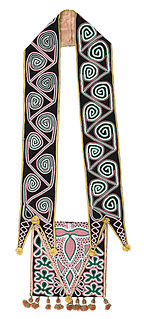
The Muscogee, also known as the Mvskoke, Muscogee Creek, and the Muscogee Creek Confederacy, are a group of related indigenous peoples of the Southeastern Woodlands in the United States of America. Their original homelands are in what now comprises southern Tennessee, much of Alabama, western Georgia and parts of northern Florida.

Commerce is a city in Jackson County, Georgia, United States, 70 miles (110 km) northeast of Atlanta. As of the 2020 census, the city had a population of 7,387.
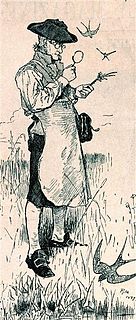
John Bartram was an early Anglo-American colonial botanist, horticulturist, and explorer, based in Philadelphia, Pennsylvania, for most of his career. Swedish botanist and taxonomist Carl Linnaeus said he was the "greatest natural botanist in the world."

William Bartram was an American botanist, ornithologist, natural historian, and explorer. Bartram was author of an acclaimed book, now known by the shortened title Bartram'sTravels, which chronicled his explorations of the southern British colonies in North America from 1773–1777. Bartram has been described as "the first naturalist who penetrated the dense tropical forests of Florida."

Mark Catesby was an English naturalist who studied the flora and fauna of the New World. Between 1729 and 1747 Catesby published his Natural History of Carolina, Florida and the Bahama Islands, the first published account of the flora and fauna of North America. It included 220 plates of birds, reptiles, amphibians, fish, insects, mammals and plants.

The Yuchi people, also spelled Euchee and Uchee, are a Native American tribe based in Oklahoma.

Paynes Prairie Preserve State Park is a Florida State Park, encompassing a 21,000-acre (85 km2) savanna in Alachua County, Florida lying between Micanopy and Gainesville. It is also a U.S. National Natural Landmark. It is crossed by both I-75 and U.S. 441. It is in the center of the Paynes Prairie Basin. The basin's primary source of drainage is Alachua Sink. During occasional wet periods, the basin will become full. A notable period occurred from 1871 to 1891 when the Alachua Sink was temporarily blocked. During this period, shallow draft steamboats were a frequent sight on Alachua Lake in the center of the prairie. The region was also historically known as the Alachua Savannah. Its drainage has been modified by several canals. Since 1927, Camps Canal has linked the basin to the River Styx which leads to Orange Lake and eventually the Atlantic Ocean through the St. Johns River. That reduced the basins water intake by half. Additional changes to the prairie's environment have been detrimental to its hydrology. In 1970, the state of Florida acquired the land and has been in the process of restoring the environment to a more natural condition ever since.

John Eatton Le Conte, Jr. was an American naturalist. He was born near Shrewsbury, New Jersey, the son of John Eatton Le Conte and Jane Sloane Le Conte. He graduated from Columbia College, where he showed an interest in science and was taught natural history by David Hosack, founder of Elgin Botanical Garden.
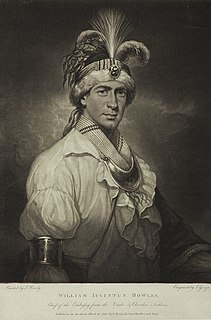
William Augustus Bowles (1763–1805), also known as Estajoca, was a Maryland soldier and adventurer. Seeing action as a Loyalist during the Revolutionary War, Bowles later formed an alliance with the Muscogee people and attempted to establish an independent indigenous American state with British support.

Attakullakulla was an influential Cherokee leader and the tribe's First Beloved Man, serving from 1761 to around 1775. His son was Dragging Canoe, a leader of the Chickamauga Cherokee.

Manatee Springs State Park is a Florida State Park located six miles west of Chiefland on SR 320, off US 19. Manatee Spring is a first magnitude spring that flows directly into the Suwannee River by way of a short run. Present also are swamps and hardwood wetlands along the Suwannee, along with many sinkhole ponds, including one with a cave 90 feet below the ground that connects to a popular divers' destination known as the catfish hotel.
Nature writing is nonfiction or fiction prose or poetry about the natural environment. Nature writing encompasses a wide variety of works, ranging from those that place primary emphasis on natural history facts to those in which philosophical interpretation predominate. It includes natural history essays, poetry, essays of solitude or escape, as well as travel and adventure writing.
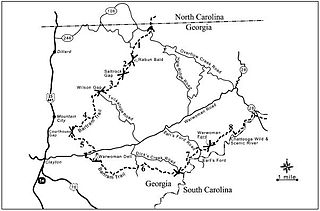
The Bartram Trail follows the approximate route of 18th-century naturalist William Bartram’s southern journey from March 1773 to January 1777. Bartram explored much of the territory which is now the states of North and South Carolina, Georgia, Florida, Alabama, Mississippi, Louisiana and Tennessee.
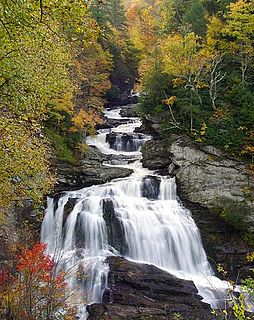
The Nantahala National Forest (/ˌnæntəˈheɪlə/), is the largest of the four national forests in North Carolina, lying in the mountains and valleys of western North Carolina. Second to the Pacific Northwest, the Nantahala is the wettest region in the country. Due to its environmental importance and historical ties with the Cherokee, the forest was officially established on January 29, 1920 by President Woodrow Wilson. The word "Nantahala" is a Cherokee derived, meaning "Land of the Noonday Sun." In some spots, the sun reaches the floors of the deep gorges of the forest only when it is high overhead at midday. This was part of the homeland of the historic Cherokee and their indigenous ancestors, who have occupied the region for thousands of years.

Keowee was a Cherokee town in the far northwest corner of present-day South Carolina. It was the principal town of what were called the seven Lower Towns, located along the Keowee River. Keowee was situated on the Lower Cherokee Traders' Path, part of the Upper Road through the Piedmont. In 1752 the Cherokee established New Keowee Town nearby, off the traders' path but in a more defensible location.

Aesculus parviflora, the bottlebrush buckeye, is a species of suckering deciduous shrub in the family Sapindaceae. The species is native to the southeastern United States, where it is found primarily in Alabama and Georgia, with a disjunct population in South Carolina along the Savannah River. Its natural habitat is in mesic forests, on bluffs and in ravines.
Nationality words link to articles with information on the nation's poetry or literature.
Francis Harper was an American naturalist known for the study of the 18th-century American naturalists John and William Bartram. His research included studies of the Okefenokee Swamp and fieldwork in the north eastern United States and in northern Canada, and authored new combinations for two species originally described by William Bartram, Garberia heterophylla and Roystonea elata.
Ahaya was the first recorded chief of the Alachua band of the Seminole tribe. European-Americans called him Cowkeeper, as he held a very large herd of cattle.

The historic Cherokee settlements were Cherokee settlements established in Southeastern North America up to the removals of the early 19th century. Several settlements had existed prior to and were initially contacted by explorers and colonists of the colonial powers as they made inroads into frontier areas. Others were established later.
















